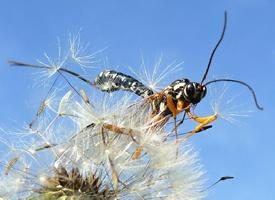
Súlyok és méretek
| Hossz | 5-tól 7-ig cm |
|---|
Állatleírás
The Sabre Wasp, scientifically known as Rhyssa persuasoria, is a remarkable species of parasitic wasp that belongs to the family Ichneumonidae. This fascinating insect is widely recognized for its striking appearance and unique reproductive behavior. It is found across various regions of Europe, Asia, and North America, thriving in woodland areas where its preferred hosts, the larvae of wood-boring insects, are abundant.The adult Sabre Wasp is an imposing figure, with females being particularly notable for their size and the impressive length of their ovipositor. Females can reach up to 4 centimeters in body length, with the ovipositor extending even further, sometimes making the insect appear almost double its actual size. The body of the Sabre Wasp is predominantly black, adorned with yellow or white markings that vary in pattern among individuals. Its wings are transparent with a slight smoky tint, adding to its elegant appearance.
One of the most fascinating aspects of the Sabre Wasp is its ovipositor, a specialized organ used for laying eggs. This needle-like structure is not only long but also incredibly flexible and strong, allowing the female wasp to drill into solid wood. The ovipositor is equipped with sensory receptors that help the wasp detect the vibrations emitted by the larvae of wood-boring insects, such as the Horntail Wasp, hidden deep within the wood. Once a suitable host is located, the Sabre Wasp skilfully uses its ovipositor to penetrate the wood and deposit an egg next to or directly onto the unsuspecting larva.
The larvae of the Sabre Wasp are parasitoids, meaning they feed on the body of their host, eventually leading to the host's death. This parasitic relationship plays a significant role in controlling the population of wood-boring insects, which can be pests to trees and timber.
The lifecycle of Rhyssa persuasoria is intricately linked to that of its host. After hatching, the larva of the Sabre Wasp consumes its host from the inside, undergoing several developmental stages before pupating within the host's body or in the surrounding wood. The following year, the adult wasp emerges, ready to continue the cycle.
Despite their fearsome appearance and parasitic nature, Sabre Wasps pose no threat to humans. They are not aggressive and do not possess a sting capable of harming humans. Instead, they are a fascinating example of nature's complexity and the intricate relationships that exist within ecosystems.
In summary, the Sabre Wasp (Rhyssa persuasoria) is a captivating species that showcases the marvels of natural adaptation and ecological balance. Its striking appearance, remarkable reproductive strategy, and role in controlling pest populations make it a subject of interest not only for entomologists but also for nature enthusiasts and conservationists alike.
Új állatfotók
Top 10 állat
- Dolphin gull (Leucophaeus scoresbii)
- Diana monkey (Cercopithecus diana)
- Moustached guenon (Cercopithecus cephus)
- Galápagos tortoise (Geochelone nigra complex)
- Japanese macaque (Macaca fuscata)
- Stone loach (Barbatula barbatula)
- Russian tortoise (Testudo horsfieldii)
- Greek tortoise (Testudo graeca)
- Common flying dragon (Draco volans)
- Vendace (Coregonus albula)